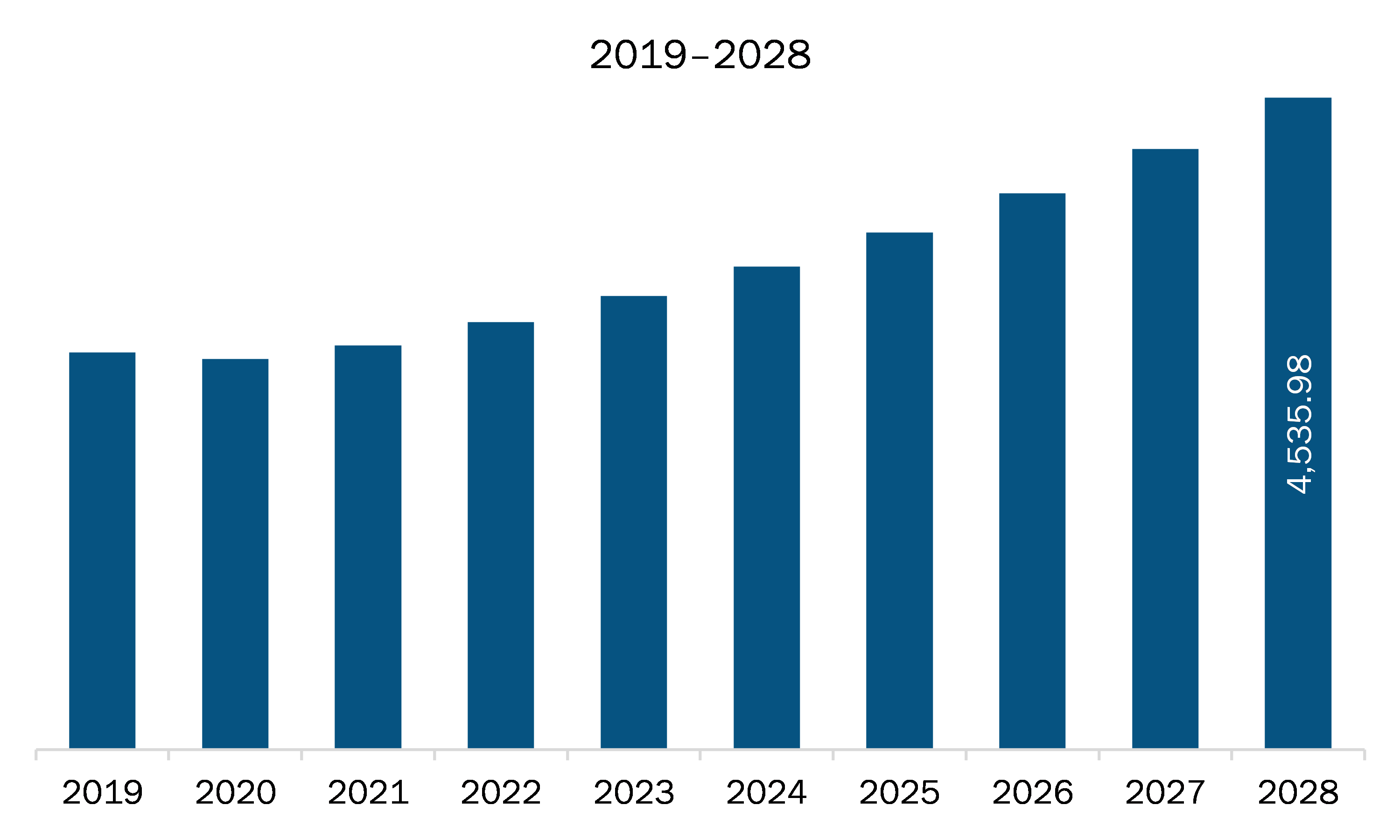The audio IC and audio amplifiers market in Europe is expected to grow from US$ 2,813.65 million in 2021 to US$ 4,535.98 million by 2028; it is estimated to grow at a CAGR of 7.1% from 2021 to 2028.
France, Germany, Italy, UK, and Russia are major economies in Europe. AI-based smart speakers getting popular is the major factor driving the growth of the Europe audio IC and audio amplifiers market. Smart speakers come with voice command recognition and virtual assistance, enabled with Bluetooth and Wi-Fi connectivity options, which aid hands-free activation and confer interactive abilities such as music playback, voice interaction, day-to-day activity listing, news streaming, and weather forecast. Smart speakers allow users to stream audio from a variety of sources with an audio request. With smart speakers gaining popularity, manufacturers are adding audio and voice functionalities such as wireless access points, soundbars, smart thermostats, and smart home hubs to their products. The aforementioned technological developments in audio systems are propelling the demand for audio amplifiers and subsequently fueling the audio IC and audio amplifier market. The AI assistance and connectivity technologies allow users to control other home automation devices via smart speakers. The growing trend of AI-enabled smart speakers is driving the proliferation of the audio IC and audio amplifier market. This trend is attributed to technological advancements in consumer electronics and increasing customer preferences for automated products with advanced features. The AI-enabled smart speakers capture sound waves and convert them into words using the automatic speech recognition (ASR) technology. Further, the verbal data is converted into meaningful sentences using the natural language understanding (NLU) technology. Once the meaning is understood, the smart speakers respond using the natural language generation (NLG) technology. Rise in preference for smart homes with luxurious entertainment systems, escalating demand for smart speakers with display features, and high inclination toward multifunctional devices, all coupled with rising per capita income of populations are among the key factors driving the sales of AI-based smart speakers, which is fueling the Europe audio IC and audio amplifier market growth.
The impact of COVID-19 varied from country to country across the European region, as selected countries witnessed a surge in the number of confirmed cases and subsequently attracted stringent and more extended lockdown periods or social isolation. However, western European countries such as Germany, France, Russia, and the UK have witnessed a comparatively moderate decline in their production activities, owing to robust healthcare infrastructure. The European economy is expected to shrink by 0.1%, with a negative growth rate in the first half of 2020, followed by a mild recovery in the second half of 2020. Countries such as UK, Italy, and Germany are expected to have a bigger impact on the economy. The imbalance in the demand and supply side and the lockdown phase in several European countries will significantly negatively impact the audio IC and audio amplifier market in the first half of the year 2020. The reduced production is hampering the growth of the audio IC and audio amplifier market as there was the shutdown of production plants and labor scarcity.
Moreover, the lockdown phase has drastically affected the supply chain. European countries under lockdowns have suffered financial crises, leading to the shutdown of manufacturing units in this region. However, the market is expected to have a significant growth rate during the forecast period. Thus, the overall impact of COVID-19 on the European region is low to moderate.
With the new features and technologies, vendors can attract new customers and expand their footprints in emerging markets. This factor is likely to drive the Europe audio IC and audio amplifiers market. The Europe audio IC and audio amplifiers market is expected to grow at a good CAGR during the forecast period.

- This FREE sample will include data analysis, ranging from market trends to estimates and forecasts.
Europe Audio IC and Audio Amplifiers Market Segmentation
Europe Audio IC and Audio Amplifiers Market – By Audio IC Type
- A/D converter IC
- Processor IC
- Amplifier IC
- D/A converter IC
- Others
Europe Audio IC and Audio Amplifiers Market – By Audio Amplifier Class
- Class A/B
- Class D
- Class G
- Class H
Europe Audio IC and Audio Amplifiers Market, by Country
- France
- Germany
- Italy
- Russia
- UK
- Rest of Europe
Europe Audio IC and Audio Amplifiers Market - Companies Mentioned
- Cirrus Logic, Inc.
- IC Audio GmbH
- ICEpower A/S
- Infineon Technologies AG
- Maxim Integrated
- NXP Semiconductors N.V.
- Renesas Electronics Corporation
- Semiconductor Components Industries, LLC
- STMicroelectronics
- Texas Instruments Incorporated
- Toshiba Corporation
Europe Audio IC and Audio Amplifiers Report Scope
| Report Attribute | Details |
|---|---|
| Market size in 2021 | US$ 2,813.65 Million |
| Market Size by 2028 | US$ 4,535.98 Million |
| CAGR (2021 - 2028) | 7.1% |
| Historical Data | 2019-2020 |
| Forecast period | 2022-2028 |
| Segments Covered |
By Audio IC Type
|
| Regions and Countries Covered |
Europe
|
| Market leaders and key company profiles |
|
- Historical Analysis (2 Years), Base Year, Forecast (7 Years) with CAGR
- PEST and SWOT Analysis
- Market Size Value / Volume - Regional, Country
- Industry and Competitive Landscape
- Excel Dataset
Recent Reports
Testimonials
Reason to Buy
- Informed Decision-Making
- Understanding Market Dynamics
- Competitive Analysis
- Identifying Emerging Markets
- Customer Insights
- Market Forecasts
- Risk Mitigation
- Boosting Operational Efficiency
- Strategic Planning
- Investment Justification
- Tracking Industry Innovations
- Aligning with Regulatory Trends





















 Get Free Sample For
Get Free Sample For